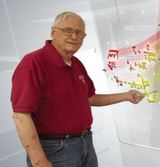
Robert (Bob) Coleman is Sr. Research Engineer for Signalysis. From his work on the Polaris rocket programs to NASA, SDRC, and Signalysis, Bob’s career spans a number of decades and experiences.
Let’s go one-on-one with Bob to learn a little more about vibrational analysis, and some downright interesting experiences. Remember, product quality isn’t rocket science; but we have one on staff just in case.
Growing up most of us wanted to be a fireman, astronaut, or something like that. Did you always want to be a physicist?
Throughout school I developed an appreciation for science and mathematics; and this led to a love of physics. But believe it or not I had every intention of becoming a concert pianist! I was given a great appreciation for music from my parents which led me to take up the piano and trumpet. I attended the University of Oklahoma through a music scholarship.
After graduation I joined the U.S. Navy where I was a member of the band and a bugler on an aircraft carrier. It was during some of those lonely dark nights on deck that I began to reflect on tuning pianos with my father and the correlation of sound, vibration, and music.
So, when did your career in noise and vibration officially begin?
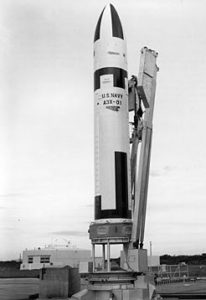
My work in vibration officially began in August of 1960. The Navy had launched the first missile from a Polaris submarine just before I arrived at the Navy Propellant Plant in Indian Head, Maryland. My title was Physicist Test Engineer for the Polaris Second-Stage Solid Rocket Motor – quite a title isn’t it! The program was extremely important at that time as tension was high between the United States and Soviet Union.
What were some of the early challenges with rocket engineering?
A serious and unusual problem emerged as rockets were being developed and tested – rocket motors were blowing up on the test stand! Testing revealed that the oscillatory pressure build-up causing the rocket case to rupture involved acoustic resonance of the rocket chamber itself.
So, it was a vibration problem.
Yes, it was. To help solve the problem we connected a speaker to an audio oscillator. The speaker and microphone were inserted into the rocket motor chamber and sinusoidal sound waves were broadcast over the audible frequency range. Certain frequencies resulted in highly amplified sounds. The failure mechanism was obvious as I immediately noticed a correlation between the dominant chamber resonance frequency and the rocket test pressure oscillation frequency.
What was the solution?
It was well known that solid propellant burning rate is exponentially sensitive to an increase in pressure. The first instance of a pressure increase due to resonant response caused an increase in burning rate with a corresponding increase in pressure. This became further amplified due to the acoustic resonance – then further increase in burning rate and pressure followed. This initiated a continuous feedback amplification mechanism with endless increasing pressure oscillations. Rocket case rupture was the only possible outcome.
Armed with this data, the propellant chemists and mechanical design engineers we were able to solve the problem. I was excited to apply my education and years of classwork in a real-world problem-solving situation.
Pretty impressive detective work considering the lack of technology as compared to today.
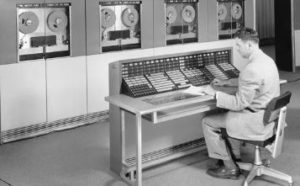
Back then it was considered cutting-edge. The project included use of the RCA 501 – one of the first discretized digital computers. The flip-flops for mathematical ones and zeros were implemented with discrete transistors. I remember the computer running hot and had to be water cooled. A large magnetic drum was used for mass-memory data storage – quite a bit different from today’s computers.
Is this what launched (pardon the pun) your work in acoustics and vibration?
Yes. As it turned out, I would have yet another encounter with vibration for the Navy. This time for the Polaris A2 program. For the engine test, a force transducer was mounted to a reinforced concrete abutment to react the rocket motor thrust and provide a force versus time measurement. I developed a dynamic math model of the rocket and test stand. Results of the analysis revealed a test stand-rocket motor-force transducer vibration resonance frequency of 94 Hz.
Testing and analysis further showed that the model resonance frequency of 94 Hz matched the measurement from the rocket motor test. This vibration showed up on the force-time measurement, obscuring the true measurement. But now the artifact component of the measured force-time could be mathematically removed, leaving just the true rocket dynamic thrust data. Little did I know then how frequently similar vibration problems would confront me and how these experiences with the Polaris rocket motor would influence my career path.
Where did your work take you next?
I later found myself in New Mexico faced with some of the same vibration problems working on Mauler and Corporal static testing at White Sands Missile Range. This time, I had two computers to work on, one was analog and the other was a computer that used electromechanical relays to store ones and zeros. But those were fun times, going up range after missile launches and witnessing the final test of the Corporal. And then, more fun at the nuclear test site in Nevada with nuclear rocket testing.
And you also worked for NASA?

NASA Houston was where all the fun was. When we think about vibration, what comes to mind is usually an engine, motor, sound wave, or how a subsystem or component reacts to vibrational forces. Over the years I’ve spent a considerable amount of time analyzing these and other vibration characteristics. But one of the more interesting applications of vibration analysis are the effects associated with payload. Believe it or not, payload vibration can have a significant, even catastrophic, effect. I’ve performed payload vibration testing and analysis for the LTV Missiles and Space Division as well as NASA. Some of the payload programs I’ve worked on include those associated with the Scout missile system, Skylab, and Space Shuttle.
My years at NASA were consumed with vibration testing and analysis. In addition to analysis on payload vibration characteristics, we performed similar tests on the crew cabin, wings, vertical tail, payload doors, body flap, and so on. Needless to say, precision and accuracy are vital to any aircraft – especially one designed to absorb the tremendous forces associated with liftoff, flight, and reentry.
Can you talk a little more about payload vibration?
Each shuttle mission included a payload of one type or another. Each unique payload had to have good dynamic design to avoid structural failure associated with vibration coupling to the payload bay during ascent. Since an unstable payload could easily have a detrimental impact on overall system performance, payload failure could be catastrophic. You can imagine the disastrous outcome of a satellite attached to the Shuttle payload bay breaking loose under excessive vibration forces during ascent. This is why every payload was subjected to vibration testing.
What was the procedure for this type of testing?
Payloads were mounted on big electrodynamic shakers – some capable of applying 50,000 pounds of force with frequencies extending to 2000 Hz. Also, ascent vibration levels, along with resulting stress levels, were predicted using finite element modeling. It was mission critical to verify that unacceptable levels were not being violated before a payload was approved for a shuttle launch.
I hear that you received an award from NASA.
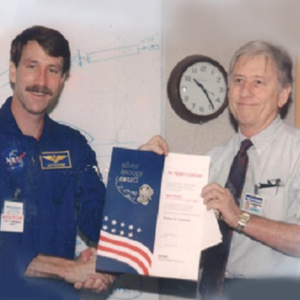
Yes, on October 7, 1993 my supervisor asked to meet in the conference room to review a project. Upon entering the room, I noticed several people were seated at the table. When I took my seat, they all got up and stood against the wall. I was beginning to wonder what was going on. Soon the NASA facility manager entered the room along with Astronaut Kent Rominger.
Astronaut Rominger presented me with NASA’s Silver Snoopy Award. The award is a special honor to NASA employees and contractors for outstanding achievements related to human flight safety or mission success. I’m very honored to have received the award for contribution to Space Shuttle orbiter damage detection using advanced vibration technology.
Those must have been exciting times. What are some of your memories from the shuttle program?
I mentioned my work with damage detection on the shuttle. As events have shown, this was a critical element of each mission. While I had the pleasure to personally meet a number of shuttle crewmembers over the years, one particular encounter stays with me. It was common for crewmembers to meet with department heads to learn more about certain aspects of the shuttle. NASA thought it important for the crew to be as familiar as possible with the ship and related sciences.
In 1985, while making a presentation to some of the astronauts on the status of shuttle vibration issues, I had the opportunity to meet astronaut Judy Resnick. I was impressed by her interest in vibration analysis and eagerness to learn more. We agreed to meet again following her next mission; she was scheduled to be a part of the Challenger mission in January of 1986. Unfortunately, that was the last time we would meet.
I imagine you worked with some pretty special people along the way.

Absolutely. I was fortunate to have had an opportunity to interview for a position working with Werhner von Braun testing rocket motors. I thought that the interview went well as they seemed impressed that my expertise covered both electronics and mechanical vibration. As time went by, I hadn’t heard anything from them and accepted a position at the U.S. Navy propellant plant. Shortly after, as fate would have it, I received as offer to join von Braun. By this time, however, I was too involved with the Polaris project and turned the offer down. I admit that it was a difficult decision.
And I can’t reflect on those years without recalling the impact a couple of people had on my professional development: Albert Klosterman and Dave Brown. These two were leaders, essentially founders, of the vibration test and analysis industry. Klosterman was the director of research and development of at Structural Dynamics Research Corporation (SDRC – now Siemens PLM) and Brown headed up the Structural Dynamics Research Lab at the University of Cincinnati. While heading up the experimental modal analysis effort at NASA, I bought into the SDRC technology – experimental as well as Finite Element Modeling. It was through encounters with these two that really fully engaged me in the application of normal mode vibration theory.
And finally, you end up at Signalysis.
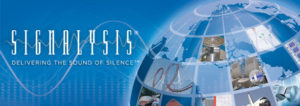
I suppose that it was inevitable that at some point I would leave Houston and move north to Cincinnati. My two sons started a company there and were anxious to get some NASA technology transfer. Signalysis has expertise in NVH testing and provides end-of-production quality inspection test systems to manufacturers throughout the automotive, medical, appliance and related industries.
These past few years have allowed me to apply aerospace vibration technology and methodology to help manufacturers identify defects at the end of manufacturing plant assembly lines. When you think about the consequences of warranty claims, lost sales, and poor reputation associated with quality issues, these systems have proven to be extremely valuable.
Today I apply much of what I’ve learned to advance the capabilities of Signalysis. For example, some of the NASA technology has been put to work by Signalysis, using intrinsic vibration characteristics to detect product defects on assembly lines of numerous plants across North America and abroad.
While technology and products have certainly advanced in the past 50 years, I suppose that noise and vibration issues remain a constant?
Absolutely – whether you’re talking about rocket science, an automobile seat motor, dental tool, or kitchen appliance, I can assure you that vibration issues are no more important to the engineers at NASA as they are to motor manufacturers.
Your story is an interesting one. You should write a book.

Well, as a matter of fact I have. But not about my personal experiences. My book discusses acoustics and vibration. “Experimental Structural Dynamics: An Introduction to Experimental Methods of Characterizing Vibrating Structures”. The book helps develop an understanding of the theory underlying the simple vibratory process, as well as developing the concepts allowing application of this understanding to the analysis of any complicated vibratory process for the most complex structure. You can request a copy through Signalysis. I believe there is information on the Signalysis web site.
(Note: Go here to request a copy.)
Thank you for your time. So, what does the future hold for Bob Coleman?
While at NASA I helped to develop methodology for damage detection. This was used to assess post-mission damage to the shuttle. Today I’m interested in applying this same methodology for manufacturers. Think of the advantage for a manufacturer who can not only identify defective parts; but who can take things a step farther and isolate exactly where within the product the defect resides.
From a development perspective, this has some obvious challenges. Think of all the components, assemblies and subassemblies that are monitored on the shuttle. With 500 to 1,000 measurements needed to generate a vibration analysis, this is a complicated and lengthy task. On the other hand, while we at NASA had weeks to analyze and make decisions the pass/fail window for end-of-production inspection systems is just a few seconds.
Today we are leveraging Space Shuttle testing technology to overcome assembly line constraints and cycle-time restrictions. Allowing vibration deformation patterns to be developed in seconds enables a more thorough analysis, and perhaps in the near future, we’ll be able to pinpoint and graphically display exact areas of defect.
